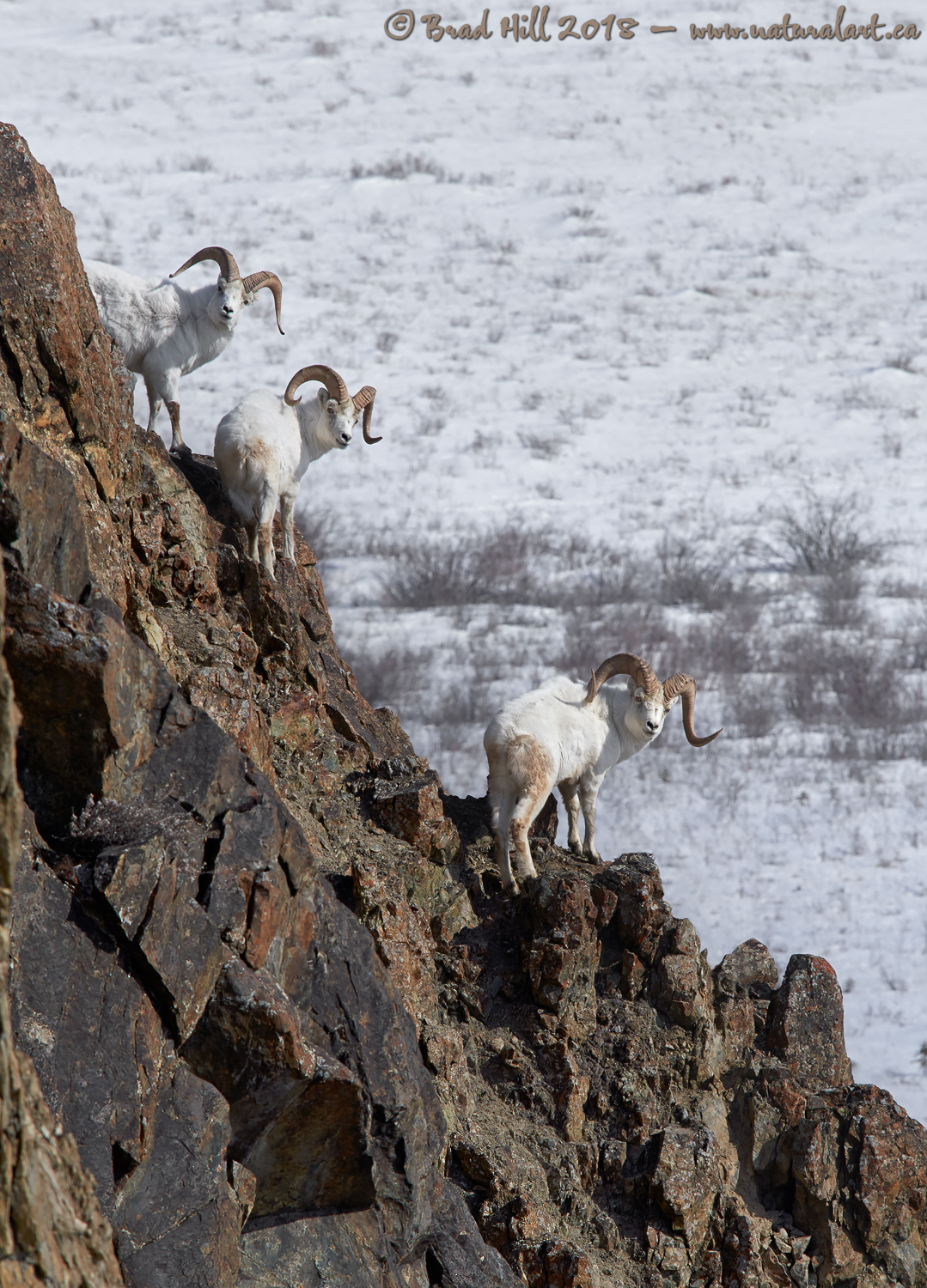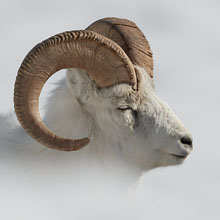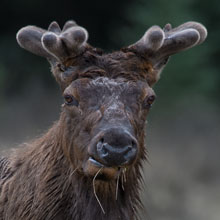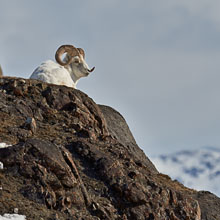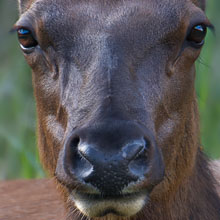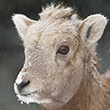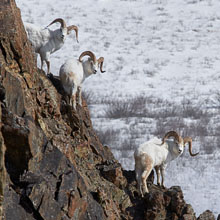Availability: Undetermined - Enquiries?
In the Field
Life on the Edge. Kluane National Park, Yukon Territory, Canada. April 1, 2017.
f you're keen on finding and photographing any of North America's "mountain" sheep and in you're in an environment that still has significant numbers of natural predators, then your best bet is to go look for steep, rocky, and difficult to negotiate terrain! Nothing explains the distribution, physical attributes, and the behavior of mountain sheep more fully than their need for - and complete dependence on - escape terrain where they can evade their primary predators.
I photographed these three beautiful white Dall Sheep Rams high on steep, rocky mountainside in Kluane National Park in Canada's Yukon Territory. This shot works for me because it shows so well how even the big rams "cling" to steep terrain to avoid predators. Earlier on this same day we had found fresh evidence of wolf predation on a hapless ram that was caught on the valley bottom almost right below where this shot was captured. So it's no wonder that when these rams saw us they thought it prudent to "hang" on this precarious and rocky slope until they were sure we posed no danger to them.
This was a tough shot to pull off. In a perfect world I would have liked a little more separation between the rams and the light background (i.e., a softer focus on the background). But two things made me reluctant to open up the aperture any more (this shot was captured at f8). First, in situations like this it's tough to instantly assess if all the subjects are on the same plane of focus. The last thing you want in a shot like this is to have ONE (or possibly two) of the animals in focus and third noticeably out of focus. Second, if I had opened up the aperture more I would have thrown more of the foreground out of focus (and all of it MORE out of focus). As I've mentioned many times on this website, my own preference is to avoid multiple out-of-focus zones in a single shot (in most scene types). Unless one chooses to really stare at the rock in the lower left corner of this shot, the perception here is that is there is only one focus transition - that from sharp focus on the foreground and the three subjects through to the softer focus in the distant background.
I suppose if I had the time to yank out my tripod and "set up" I could have opened up the aperture more and shot the raw material for a focus stack here (i.e., shots with different focus points in foreground and on the sheep) and ended up with a softer background after merging the shots. But if I had tried that here I would have had - at best - a very nice shot of three sheep butts as the disappeared around the rock face! Always compromises, eh?
Here's a larger (2400 pixel) version of this "edgy" trio of Dall rams:
• Life On the Edge: Download 2400 pixel image (JPEG: 1.74 MB)
ADDITIONAL NOTES:
1. This image was captured in the same location that will be hosting my "Kluane-Haines Explorer" Exploratory Photo Adventure in late autumn of 2018. Each year I offer trips into two different parts of the Great Bear Rainforest as well as one to photograph marine mammals and oceanscapes near the northern tip of Vancouver Island. And, in selected years, I also offer photo tours to locations to capture other highly sought-after subjects, such as Dall Sheep, Bald Eagles, and more. Details about these trips can be found on the Photo Tours page of this website.
2. This image - in all resolutions - is protected by copyright. I'm fine with personal uses of them (including use as desktop backgrounds or screensavers on your own computer), but unauthorized commercial use of the image is prohibited by law. Thanks in advance for respecting my copyright!
3. Like all wildlife photographs on this website, this image was captured following the strict ethical guidelines described in The Wildlife FIRST! Principles of Photographer Conduct. I encourage all wildlife photographers to always put the welfare of their subjects above the value of their photographs.
Behind the Camera
Life on the Edge. Kluane National Park, Yukon Territory, Canada. April 1, 2017.
Digital Capture; Compressed RAW (NEF) 14-bit format; ISO 100.
Nikon D500 paired with Nikkor 300mm f4 PF VR (450mm EFL). Hand-held. VR on and in Sport mode.
1/640s @ f8; No compensation from "recommended" matrix-metered exposure setting.
At the Computer
Life on the Edge. Kluane National Park, Yukon Territory, Canada. April 1, 2017.
RAW Conversion to 16-bit TIFF using Phase One's Capture One Pro 10. Three raw variants (different versions of a single raw capture) processed, with the variants differing only in exposure settings (with 0.5 stops total exposure difference).
Further digital correction on resulting 16-bit TIFF files using Adobe's Photoshop CC 2018. Photoshop adjustments included compositing (blending) of the three output files from the raw converter, minor exposure tweaks, and final selective sharpening for web output. Final selective tone-tweaking performed using LightZone's "tonemapper" tool.
Note that this shot was processed from raw BEFORE I had transitioned to a workflow that more fully utilized the selective editing capabilities of Capture One Pro.
Conservation
Life on the Edge. Kluane National Park, Yukon Territory, Canada. April 1, 2017.
Species Status in Canada*: Not listed as of Special Concern, Threatened, or Endangered.
The Dall Sheep (Ovis dalli) is a species of sheep native to northwestern North America. They inhabit the subarctic mountain ranges of Alaska, the Yukon Territory, the MacKenzie Mountains in the Northwest Territories, and both central and northern British Columbia. The more southern form is known as the Stone Sheep and is slaty brown in colour with some white patches on the rump on the inside of the hind legs. Dall sheep are found in comparatively dry country and tend to be found in a unique combination of open alpine ridges, meadows, and steep slopes with extremely rugged ground (usually referred to as escape terrain) in the immediate vicinity. This escape terrain allows the sheep to escape from predators that can't travel as fast as these sure-footed sheep. The primary predators of Dall sheep include wolves, coyotes, black and grizzly bears and, during the lambing season, both golden eagles and wolverines.
While not technically endangered in Canada this Stone Sheep was photographed in the southwest portion of the Yukon Territory - and in this region poorly regulated and poorly managed hunting has reduced many local populations by over 50% compared to historical levels. In some populations local extirpation is likely if hunting practices are not radically changed or completely suspended.
*as determined by COSEWIC: The Committee on the Status of Endangered Wildlife in Canada












